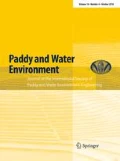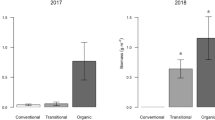Abstract
The Ebro Delta (Catalonia, Spain) is one of the largest wetland areas in the Mediterranean with 65% of its area occupied by rice fields. Because of the crucial role of rice fields in biodiversity and the regional economy, it is essential to find an optimum equilibrium between wetland conservation and rice productivity. The environmental and agronomic effects of three cropping systems with different degrees of farming intensity (organic, agri-environmental scheme and conventional) were assessed. The three cropping systems mainly differed in the use of agrochemicals, type of fertilizer and winter flooding. A 3-year field study was conducted in which agronomic performance and diversity and dynamics of macrophyte community in rice fields were assessed. Agri-environmental system yielded the same as the conventional one, whereas organic system significantly reduced grain yield. Biomass of weeds and macrophytes was the main contributor to yield decline. Both organic and agri-environmental systems, through winter flooding, promote the ecological succession and temporal heterogeneity of the macrophyte community in rice fields, whereas less impact on macrophyte diversity was observed. Filamentous algae were the most abundant group irrespective of the cropping system, followed by Chara vulgaris, Najas minor and Lemna minor in conventional, organic and agri-environmental systems, respectively. The environmental and agronomic benefits of winter flooding are discussed along with the current limitations of organic farming and suggested measures to make it agronomically feasible. This discussion is done under an integrative approach in which the agri-environmental legislation for the last 20 years is examined.







Similar content being viewed by others

References
Altieri MA (1999) The ecological role of biodiversity in agroecosystems. Agric Ecosyst Environ 74:19–31
Bambaradeniya CNB, Edirisinghe JP, De Silva DN, Gunatilleke CVS, Ranawana KB, Wijekoon S (2004) Biodiversity associated with an irrigated rice agro-ecosystem in Sri Lanka. Biodivers Conserv 13:1715–1753
Barclay AM, Crawford RMM (1982) Plant Growth and Survival under Strict Anaerobiosis. J Exp Bot 33:541–549
Barrett SCH, Seaman DE (1980) The weed flora of Californian rice fields. Aquat Bot 9:351–376
Bengtsson J, AhnstrÖ MJ, Weibull AC (2005) The effects of organic agriculture on biodiversity and abundance: a meta-analysis. J Appl Ecol 42:261–269
Bird JA, Pettygrove GS, Eadie JM (2000) The impact of waterfowl foraging on the decomposition of rice straw: mutual benefits for rice growers and waterfowl. J Appl Ecol 37:728–741
Blackshaw RE, Larney FO, Lindwall CW, Kozub GC (1994) Crop rotation and tillage effects on weed populations on the semi-arid Canadian prairies. Weed Technol 8:231–237
Bolòs O, Vigo J, Masalles RM, Ninot JM (1998) Flora manual dels països Catalans. Editorial Pòrtic S.A. (in Catalan)
Bowmer KH, Muirhead WA (1987) Inhibition of algal photosynthesis to control pH and reduce ammonia volatilization from rice floodwater. Fert Res 13:13–29
Brogi A, Pernollet CA, Gauthier-Clerc M, Guillemain M (2015) Waterfowl foraging in winter-flooded ricefields: any agronomic benefits for farmers? Ambio. doi:10.1007/s13280-015-0678-0
Canicio A, Ibáñez C (2000) Innovacions en el conreu d’arròs ecològic a l’Ebre. Agro-Cultura 4:20–21 (in Catalan)
Canicio A, Català MM, Escolano MA, Ferreres A, Galimany G, Moisés J, Rauly T, Reverté V (2008) El cultiu d'arròs ecològic en zones costeres. Generalitat de Catalunya, Departament d’Agricultura, Alimentació i Acció Rural. Unitat d’Agricultura Ecològica, Barcelona (in Catalan)
Casanova D, Goudriaan J, Català MM, Withagen JCM (2002) Rice yield prediction from yield components and limiting factors. Eur J Agron 17:41–61
Català MM, Tomàs N, Martínez-Eixarch M, Pla E (2008) Evaluation of the effect of chironomidae during late sowing on the culture of rice in the Ebre delta. Agricola 27:417–420 (in Spanish)
Colmer TD, Voesenek LACJ (2009) Flooding tolerance: suites of plant traits in variable environments. Funct Plant Biol 6:665–681
Concepción E, Díaz M, Baquero R (2008) Effects of landscape complexity on the ecological effectiveness of agri-environment schemes. Landsc Ecol 23:135–148
de Ponti T, Rijk B, van Ittersum MK (2011) The crop yield gap between organic and conventional agriculture. Agr Syst 108:1–9
Delmotte S, Tittonell P, Mouret JC, Hammond R, Lopez-Ridaura S (2011) On farm assessment of rice yield variability and productivity gaps between organic and conventional cropping systems under Mediterranean climate. Eur J Agron 35:223–236
Derksen DA, Lafond GP, Thomas AG, Loeppky HA, Swanton CJ (1993) Impact of agronomic practices on weed communities: tillage systems. Weed Sci 41:409–417
Dingkuhn M, Schnier H, Datta S, Wijangco E, Dorffling K (1990) Diurnal and developmental changes in canopy gas exchange in relation to growth in transplanted and direct-seeded flooded rice. Funct Plant Biol 17:119–134
Eagle AJ, Bird JA, Hill JE, Horwath WR, van Kessel C (2001) Nitrogen dynamics and fertilizer use efficiency in rice following straw incorporation and winter flooding. Agr J 93:1346–1354
Elphick CS, Oring LW (2003) Conservation implications of flooding rice fields on winter waterbird communities. Agr Ecosyst Environ 94:17–29
Fogliatto S, Vidotto F, Ferrero A (2010) Effects of winter flooding on weedy rice (Oryza sativa L.). Crop Prot 29:1232–1240
Hasegawa H, Furukawa Y, Kimura SD (2005) On-farm assessment of organic amendments effects on nutrient status and nutrient use efficiency of organic rice fields in Northeastern Japan. Agr Ecosyst Environ 108:350–362
Hokazono S, Hayashi K (2012) Variability in environmental impacts during conversion from conventional to organic farming: a comparison among three rice production systems in Japan. J Clean Prod 28:101–112
Hole D, Perkins A, Wilson J, Alexander I, Grice P, Evans AD (2005) Does organic farming benefit biodiversity? Biol Conserv 122:113–130
Ibañez C (2000) Integrated management in the Special Protection Area of the Ebre Delta: implications of rice cultivation for birds. In: Proceedings of the Conference on the Council Directive on the Conservation of Wild Birds, pp 98–103
Ibañez C, Curcó A, Riera X, Ripoll R, Sánchez C (2010) Influence on birds of rice field management practices during the growing season: a review and an experiment. Waterbirds 33:167–180
Katayama N, Baba YG, Kusumoto Y, Tanaka K (2015) A review of post-war changes in rice farming and biodiversity in Japan. Agric Syst 132:73–84
Krebs ChJ (1989) Ecological methods. Harper Collins Publishers, NewYork
Lawler SP, Dritz DA (2005) Straw and winter flooding benefit mosquitoes and other insects in a rice agroecosystem. Ecol Appl 15:2052–2059
Linke MG, Godoy RS, Rolon AS, Maltchik L (2014) Can organic rice crops help conserve aquatic plants in southern Brazil wetlands? Appl Veg Sci 17:346–355
Lundkvist A, Salomonsson L, Karlsson L, Gustavsson AMD (2008) Effects of organic farming on weed flora composition in a long term perspective. Eur J Agron 28:570–578
Marenco RA, Santos AMB (1999) Crop rotation reduces weed competitions and increases chlorophyll concentration and yield or rice. Pesq agropec bras 34:1881–1887
Mouret J, Hammond R, Dreyfus F, Desclaux D, Marnotte P, Mesleard F (2004) An integrated study of the development of organic rice cultivation in the Camargue (France). In: International Conference on challenges and opportunities for sustainable rice-based production systems, Torino, 13–15 Sept 2004
Nelms CO, Twedt DJ (1996) Seed deterioration in flooded agricultural fields during winter. Wildl Soc Bull 24:85–88
Norton L, Johnson P, Joys A, Stuart R, Chamberlain D, Feber R, Firbank L, Manley W, Wolfe M, Hart B, Mathews F, Macdonald D, Fuller RJ (2009) Consequences of organic and non-organic farming practices for field, farm and landscape complexity. Agr Ecosyst Environ 129:221–227
Pan G, Zhou P, Li Z, Smith P, Li L, Qiu D, Zhang X, Xu X, Shen S, Chen X (2009) Combined inorganic/organic fertilization enhances N efficiency and increases rice productivity through organic carbon accumulation in a rice paddy from the Tai Lake region, China. Agr Ecosyst Environ 131:274–280
Pasuquin E, Lafarge T, Tubana B (2008) Transplanting young seedlings in irrigated rice fields: early and high tiller production enhanced grain yield. Field Crop Res 105:141–155
Pernollet CA, Guelmami A, Green AJ, Curcó A, Dies B, Bogliani G, Tesio F, Brogi A, Gauthier-Clerc M, Guillemain M (2015) A comparison of wintering duck numbers among European rice production areas with contrasting flooding regimes. Biol Conserv 186:214–224
Rao AN, Johnson DE, Sivaprasad B, Ladha JK, Mortimer AM (2007) Weed management in direct-seeded rice. Adv Agron 93:153–255
Roger PA, Watanabe I (1984) Algae and aquatic weeds as source of organic matter and plant nutrients for wetland rice. In: Organic matter and rice (ed). International Rice Research Institute, Los Baños, Phillipines
Rolon AS, Homem HF, Maltckik L (2010) Aquatic macrophytes in natural and managed wetlands of Rio Grande do Sul State, Southern Brazil. Acta Limnol, Bras, p 22
Saito M, Watanabe I (1978) Organic matter production in rice field flood water. Soil Sci Plant Nutr 24:427–440
SAS Institute Inc (2008) Base SAS® 9.2 Procedures guide: statistical procedures, Third Edition. SAS Institute Inc, Cary, NC
Shuurman JJ, Goedewaagen MAJ (1971) Methods for the examination of root systems and roots, in methods in use at the Institute for Soil Fertility for eco-morphological root investigations, 2nd edn. Centre for Agricultural Publishing and Documentation, Wageningen
Singh S, Sharma SN, Prasad R (2001) The effect of seeding and tillage methods on productivity of rice–wheat cropping system. Soil Till Res 61:125–131
Singh S, Singh G, Singh VP, Singh AP (2005) Effect of establishment methods and weed management practices on weeds and rice in rice-wheat cropping system. Indian J Agric Sci 37:51–57
Singh V, Burgos N, Sing S, Abugho S, Earnest L, Gbur E, Scott R (2016) Herbicide and winter flood treatments for controlling volunteer rice off-season. Crop Prot 79:87–96
Smith RJ (1983) Weeds of major economic importance in rice and yield losses due to weed competition. In: Proceedings of the Conference on Weed Control in Rice. International Rice Research Institute (ed) International Weed Science Society, Los Baños
Uruma H, Kobayashi K, Nishijima S, Miyashita T (2012) Effectiveness of conservation-oriented agricultural practices on amphibians inhabiting Sado Island, Japan, with a consideration of spatial structure. Jpn J Conserv Ecol 17:155–164 (in Japanese with English summary)
Valverde B (2005) Can feral rice remain undetected? In: Gressel J (ed) Crop ferality and volunteerisms. CRC Press, Boca Raton
van Diepen LTA, van Groenigen JW, van Kessel C (2004) Isotopic evidence for changes in residue decomposition and N-cycling in winter flooded rice fields by foraging waterfowl. Agr Ecosyst Environ 102:41–47
Van Groenigen J, Burns E, Eadie J, Horwath W, Van Kessel C (2003) Effects of foraging waterfowl in winter flooded rice fields on weed stress and residue decomposition. Agr Ecosyst Environ 95:289–296
Vasconcelos T, Tavares M, Gaspar N (1999) Aquatic plants in the rice fields of the Tagus Valley, Portugal. Hydrobiologia 415:59–65
Vriezen WH, Zhou Z, Van Der Straeten D (2003) Regulation of Submergence-induced Enhanced Shoot Elongation in Oryza sativa L. Ann Bot 91:263–270
Xie Y, Yu D, Ren B (2004) Effects of nitrogen and phosphorus availability on the decomposition of aquatic plants. Aquat Bot 80:29–37
Yamada S, Kusumoto Y, Tokuoka Y, Yamamoto S (2011) Landform type and land improvement intensity affect floristic composition in rice paddy fields from central Japan. Weed Res 51:51–62
Zhang B, Pang C, Qin J, Liu K, Xu H, Li H (2013) Rice straw incorporation in winter with fertilizer-N application improves soil fertility and reduces global warming potential from a double rice paddy field. Biol Fert Soils 49:1039–1052
Acknowledgements
The work on the case study of the Ebre Delta was funded by the European Union through the Life-Nature project “Improvement of Habitat Management in the Special Protection Area of the Ebre Delta” (Life96NAT/E/3133). The authors would like to thank Dr. David Mann, from Royal Botanic Garden Edinburgh and IRTA-Aquatic Ecosystems, for the revision of the manuscript.
Author information
Authors and Affiliations
Corresponding author
Electronic supplementary material
Below is the link to the electronic supplementary material.
Rights and permissions
About this article
Cite this article
Martínez-Eixarch, M., Curcó, A. & Ibáñez, C. Effects of agri-environmental and organic rice farming on yield and macrophyte community in Mediterranean paddy fields. Paddy Water Environ 15, 457–468 (2017). https://doi.org/10.1007/s10333-016-0563-x
Received:
Revised:
Accepted:
Published:
Issue Date:
DOI: https://doi.org/10.1007/s10333-016-0563-x



